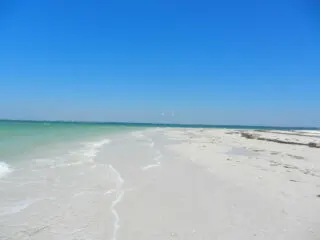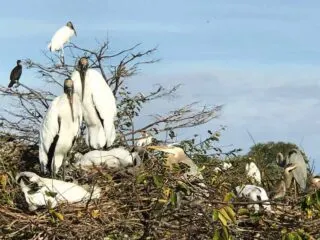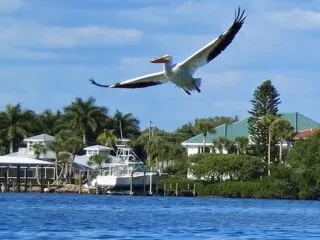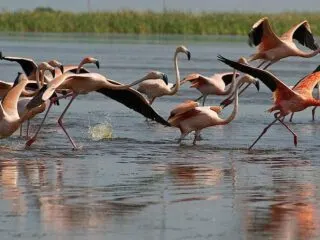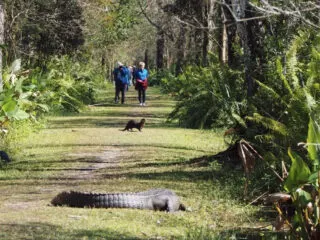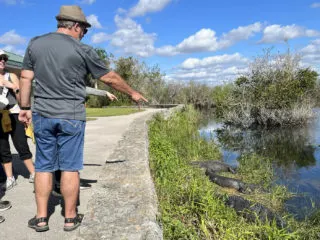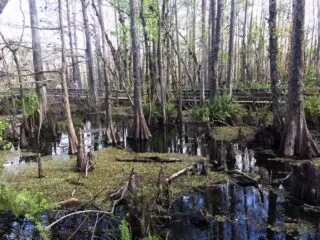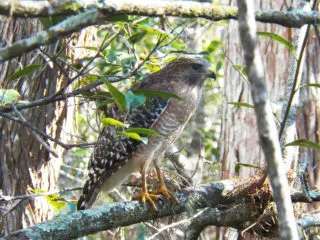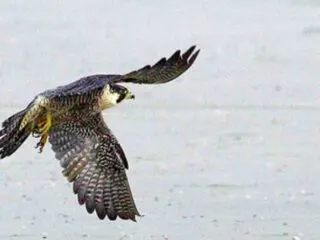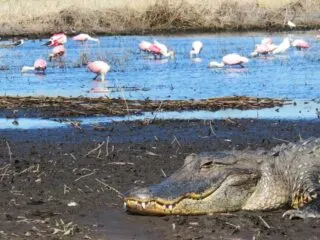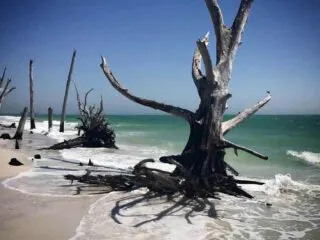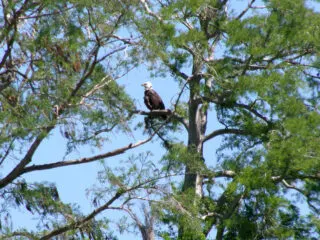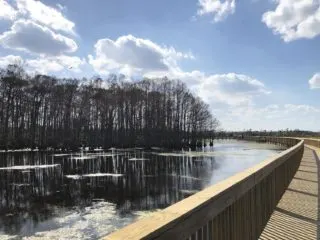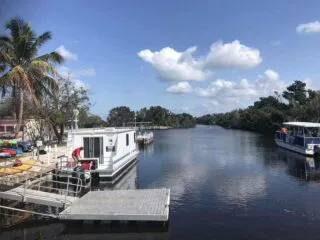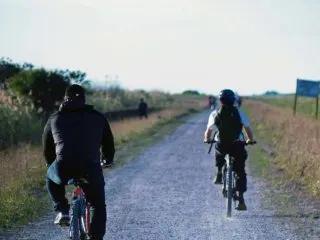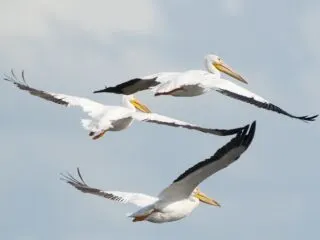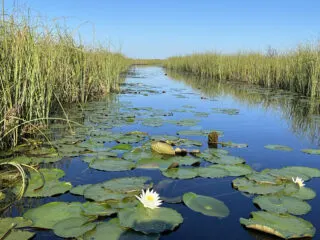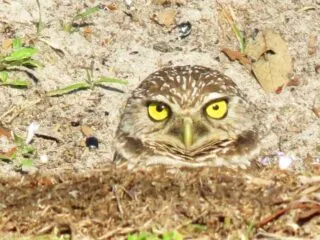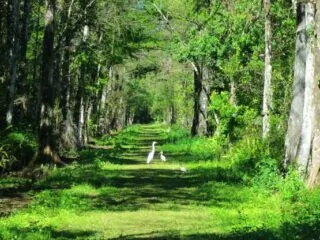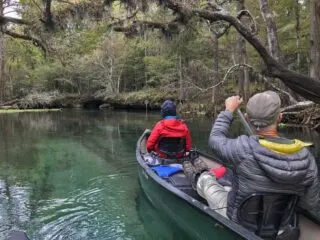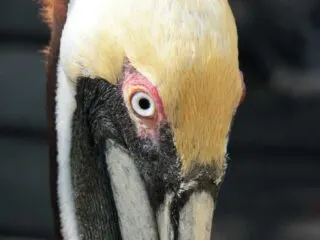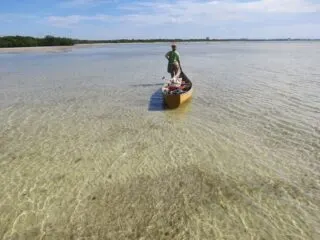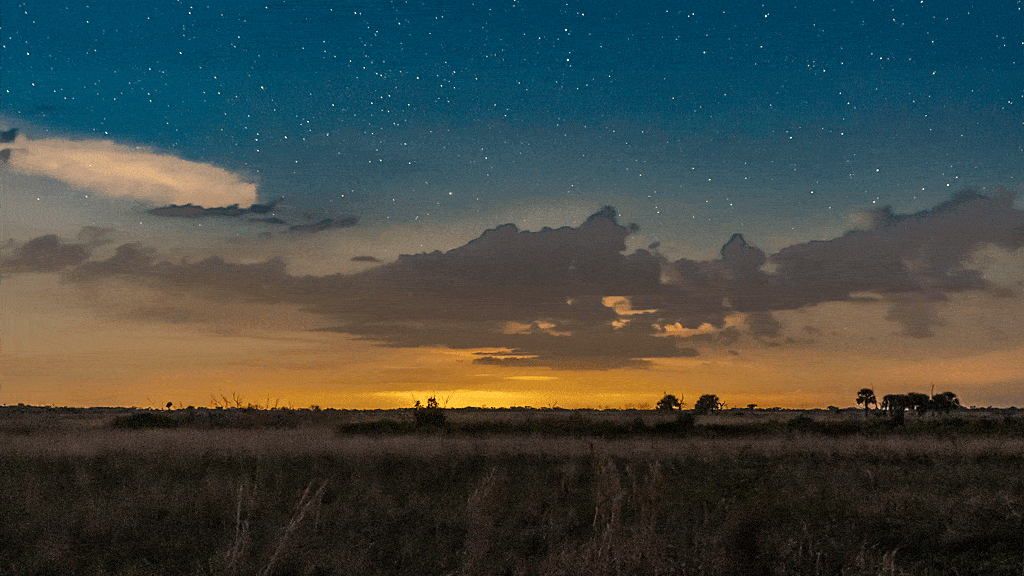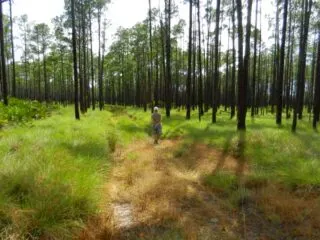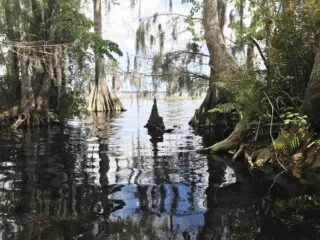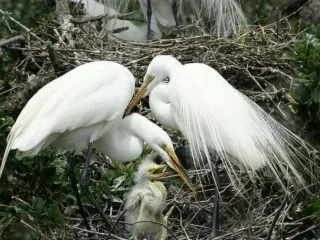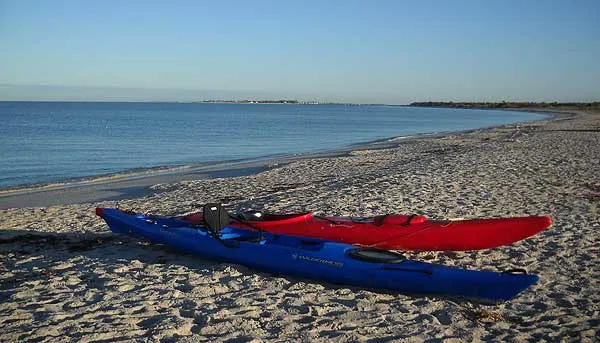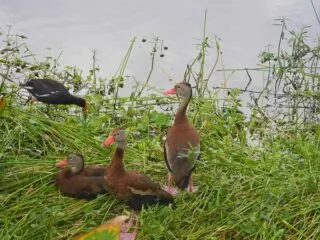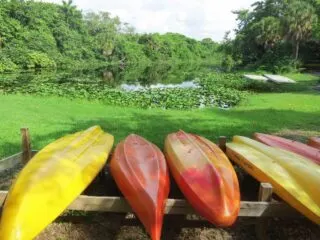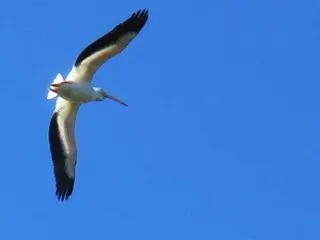Honeymoon Island has a big, natural beach where you can get away from people, but also offers a cafe, bikes and kayaks to rent and a playground. Recently, the beautiful sandspit beach that extends miles north split in two! Erosion has connected the Gulf to the Intracoastal, and it’s still shifting. Don’t worry: There are still miles of beach to walk.
Florida Birding
One of the best places to see wood storks and other wading birds nesting up close in spring is Wakodahatchee Preserve in Delray Beach. In February to April, dozens of storks build nests close to an easy-to-walk .75 mile boardwalk.
The Gulf coast along Charlotte Harbor has miles of wild shoreline, making it a wonderland of wildlife and natural beauty and ideal for sea kayaking.
Wild flamingos are spotted occasionally in Florida. A hurricane, however, brought many more of the pink birds to new locations. Where can you see them? We have some tips.
No matter how many times I see them, the sight of a white pelican, bald eagle or an otter will make my day. These spots are favorites for providing reliable views of animals in beautiful settings.
Updated for 2024: If you have one day or its your first visit to the Everglades, this guide will help you see wildlife and experience the essence of Everglades National Park. We offer tips, too, for more in-depth Everglades experiences.
Next time you travel Florida’s Gulf Coast on I-75, take a five minutes detour in Fort Myers to discover a magnificent slice of old Florida – a 1.2 mile boardwalk through an unspoiled cypress swamp called Six Mile Cypress Slough Preserve. It’s free!
The Corkscrew Swamp Sanctuary in Naples, an Audubon Society preserve, takes you on a hike via boardwalk with good wildlife viewing and exquisite scenery. In summer, you might get a peak at the rare ghost orchid blooming.
Every fall, the skies over the Florida Keys fill with thousands of birds from hundreds of species heading south for the winter. A remarkable citizen science project, Hawkwatch, based in Curry Hammock State Park, keeps a tally.
Myakka is one of the oldest and biggest state parks, a great place for seeing wildlife, from huge gators to flocks of birds in winter. Go here for its log cabins, appealing camp sites, excellent kayaking, extensive hiking and good bike trails. It’s also a good spot for nature neophytes, who enjoy the airboat ride and canopy walk.
Some sections of the 2.5 mile beach remain closed. Otherwise, the park is open every day from 8 a.m. until sunset.
Twenty minutes off I-4 between Orlando and Tampa, there is a little-known wildlife preserve that one visitor calls “a free safari.” It attracts thousands of migrating birds in winter, but it has more to offer than just excellent birding.
Orlando Wetlands Park is a must-stop for birders and wildlife fans; it’s home to over 100 roseate spoonbills, 1,700 alligators and 200 species of bird. What’s even better: A half-mile boardwalk opened this winter providing great views of nesting birds in a cypress island. It’s only 20 minutes off I-95.
Renting a houseboat in Everglades National Park lets you glide into the wilderness of Whitewater Bay and experience its splendor at dawn, at sunset and marvel at its starry skies. Fishermen will love it, but even without fishing, there’s plenty to enjoy.
The Hillsboro/Parkland entrance to the Loxahatchee National Wildlife Refuge offers endless trails into South Florida’s vast and watery wildlife corridor.
White pelicans migrate to Florida in winter by the thousands. They are the sort of big, dramatic birds that even folks who don’t consider themselves birders will enjoy spotting.
It’s a perfect time to explore Loxahatchee National Wildlife Refuge in Boynton Beach. The kayak trail has been cleared of water lilies clogging the way. You can rent or launch kayaks here, but also hike an exquisite boardwalk through a cypress forest and see birds and other wildlife on the trails.
Florida birding festivals bring together experts, pros and beginners at winter events. With its varied terrain and long coastline, Florida is birding heaven. The first major birding festival starts Oct. 20.
Few South Florida hiking or biking trails rival this 12-mile-long trail near Naples for scenery and wildlife. It deserves to be known outside the Naples area.
The Ichetucknee is the most pristine spring run in the state. It has eight major springs, crystalline water, lush jungly vegetation plus plentiful birds and wildlife. It’s a shame that most visitors only experience it as a busy tubing river. It’s a fabulous winter kayaking destination in North Florida — worth a drive!
This bird rescue center offers an up-close-and-personal wildlife experience that makes a short, fun stop on a Keys trip, especially for families with kids.
People and birds alike enjoy the beautiful beaches and sandbars plus the pristine mangrove creeks at Bunche Beach. There are several routes for kayakers or it’s a great place for just combing the beach and enjoying the wildlife.
Amateur astronomers love this place in the heart of Florida’s cow country — 54,000 acres of wide-open prairie, 25 miles from the nearest town, ideal for stargazing under a pure night sky.
Lake Wales Ridge State Forest is for explorers – folks who like to find places that aren’t in the guidebooks. Here you can hike for miles in the woods, hear only nature and have a chance to spot wildlife, including bear, bald eagles and endangered scrub jays.
Chances are, you’ve never heard of Blue Cypress Lake near Yeehaw Junction. If that’s so, you’re missing a spectacular natural lake rimmed by old growth cypress trees and home to hundreds of ospreys and osprey nests. This lake is the headwaters of the mighty St. Johns River. What a great kayak destination!
This original Florida roadside attraction still thrills, especially in the spring and early summer when its rookery fills with hundreds of nesting birds. The gators and crocs are well-presented with lots of information as well as entertainment.
This wild island on the Gulf coast is never crowded — it’s too hard to get there. For those who drive to Pineland on Pine Island and then take the hour-long ferry to the state park, the rewards are many: Nine miles of perfect beaches, shaded jungle-like trails and wildlife that includes osprey nests, dolphins, stringrays and all sorts of bird and sea life.
Amid a sea of subdivisions, you’ll find a pair of man-made wetlands west of Delray Beach where you will encounter extraordinary wildlife viewing from strategically placed boardwalks. After COVID and construction closings, they are both open as of fall 2020.
This state park holds a special place in my heart. In urban South Florida, it preserves a sliver of the natural splendor once all around. There’s a lot to do here: beach, biking, shaded picnics, Intracoastal views. When visiting, a perfect day includes a stop to nearby Bonnet House.
Peaceful Waters Sanctuary is an outstanding birding site and a particularly good destination for nature-starved folks from Broward and Palm Beach counties. It’s also close to two good places for 3-mile-long walks in natural settings.


